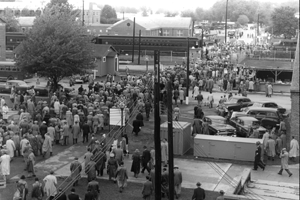100 Years of Excellence: The ATC Story, Part 3
Excerpted from an article by Lauren Nelson

Workers waiting to board Pennsylvania Rail Road passenger cars outside of the main front for their commute home.
Throughout the peacetime years, the personnel at Aberdeen Proving Ground were greatly reduced compared with the numbers during World War I. In a 1932 census, the number of military personnel totaled 150; the number of civilians nearly three times that amount, at 450. These numbers steadily increased and balanced as a new threat to peace arose and APG’s workload evolved.
War clouds in Europe signaled a new testing era for APG. As the nation carefully followed the events across the Atlantic, U.S. Armed Forces stepped up defenses, creating more work for the Proof Department. President Franklin D. Roosevelt, concerned about possible U.S. involvement in the war, visited APG in October 1940 to assess the nation’s state of readiness. President Roosevelt toured a number of facilities and test programs before departing to Washington, D.C., causing an increase in activity at APG.
Results of this busy time include the completion of an indoor firing range at Michaelsville, which protected testing from weather conditions, and Munson Test Course in 1941. The latter was a series of rough roads constructed for testing tanks, trucks, tractors, and trailers, both wheeled and tracked. Vehicles were chiefly tested for endurance, speed and handling. The course was named after Lieutenant Max Munson, who died in 1941 when an experimental vehicle rolled over on him. These test courses, as well as those built later at Churchville and Perryman, were extremely helpful in advancing automotive testing for the U.S. Army.
The December 7, 1941, attack on Pearl Harbor hurled the United States into war with Japan, and soon we were embroiled in the war in Europe as well. This heralded the expansion of the U.S. Armed Forces, which created an even more urgent need for increased activity at APG. Almost overnight, war production increased dramatically. This meant not only heightened testing, but also rapid expansion of APG. The U.S. Government purchased 7,000 more acres of land, extending APG to the Aberdeen town limits. Spesutie Island was leased for use, and purchased in 1945, from the estate of J.P. Morgan.
An increased workload calls for an increased staff. Personnel working on APG during World War II grew to 32,664 people; 27,185 military and 5,479 civilian. These extraordinary numbers illustrate the important mission of the Proof Department, which later grew into its own entity called the Proof Center in 1942. These employees served the war effort in every capacity, fully aware of the vital importance of their contribution to the U.S. military in service around the world.
During World War II every type of weapon, from a pistol to a 16-inch gun, and numerous variants of tank, tractor and jeep were tested, fired and driven at APG. The hours were grueling as personnel labored on tests through the night and through the week, including weekends. Between 200 and 350 test projects usually went on at once, and from five to a dozen directives for new projects were received weekly. There were two basic types of testing: experimental and acceptance. Experimental testing was applied to newly designed weapons to test all competencies. Acceptance testing was conducted on standard weapons to ensure they operated properly. Noteworthy results include the standardization of many rocket items, bazooka (the only completely original all-American weapon of WWII), M3 submachine gun, the M8 armored car, M12 tank destroyer and M15 half track. Other extraordinary developments include the recoilless rifle and the VT fuze, also called a proximity fuze or “the fuze that thinks.”
This fuze contained a small radio which could detonate a shell, bomb or rocket when it was in the perfect position to cause the most damage to its target. Each of these items certified that the military overseas had the best weapons technology possible in Europe, Africa and the Pacific.
All of these accomplishments were recognized when the Post received the Army-Navy “E” award for excellence in achievement in the production of war equipment on September 28, 1942. APG was the first Army-operated plant to earn the award, and the ceremony was witnessed by over 30,000 military and civilian personnel who had made it possible. Today, Aberdeen Test Center continues this tradition of excellence and applies it to every project that it undertakes.
During these days, APG’s Proof Department earned its colossal reputation. Through its hard work, ATC had become known as a “get it done” organization. A pithy, slangy slogan was in the minds of all who were dedicated to ATC’s mission: “It’s gotta be right…It’s gotta be right…It’s gotta be right.” We can now say, It was! This sentiment didn’t fade during peacetime; getting a project done quickly and right is still ATC’s highest goal.
You are now leaving www.atc.army.mil and entering another site. You will automatically be forwarded to the target page within five seconds.
